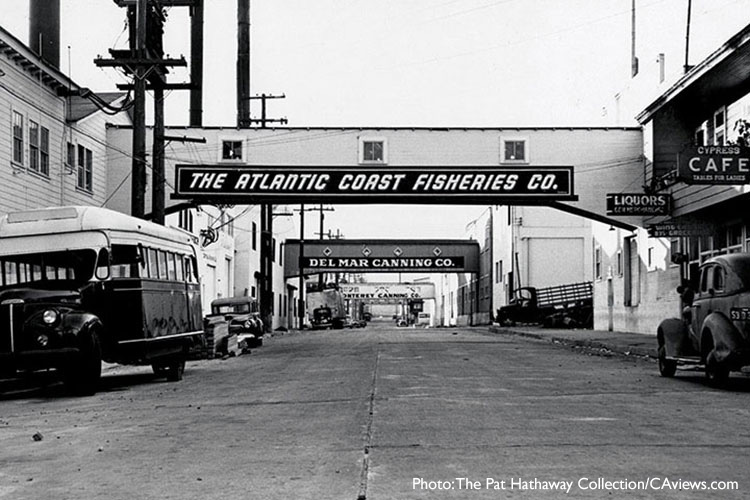John Steinbeck’s “Cannery Row” offers us a timeless portrait into human nature. Cannery Row in particular stands as a testament to the author’s unparalleled ability to capture the essence of American life and the colorful characters that we come across. Published in 1945, this novella continues to captivate readers with its vivid portrayal of a Depression-era community in Monterey, California.
Of course John Steinbeck has earned his place in literary fame. He is a great among the greats and while I had read this during school many years ago it was after a conversation with my brother in law a huge Steinbeck fan that my interest in Steinbeck was sparked again. And a copy of Cannery Row he gifted me for my birthday gave me incentive to reread it. To my delight I thoroughly loved it this second time around.
For me I think perhaps being more learned, more well read, older, wiser, with a depth of appreciation that would’ve eluded me in my younger years the fondness now is befitting of this literary masterpiece.
So what makes this work a true literary classic?
Let’s explore the unique style that sets Steinbeck apart as one of America’s most profound writers.

The Heart of Cannery Row
At its core, “Cannery Row” is a character study of the colorful inhabitants of a rundown neighborhood. Steinbeck brings to life a cast of misfits and outcasts, from the good-hearted but mischievous Mack and the boys to the enigmatic Doc, based on Steinbeck’s friend Ed Ricketts. Through these characters, Steinbeck paints a rich tapestry of human experience, exploring themes of community, belonging, and the pursuit of happiness in unlikely places.
The plot, such as it is, revolves around the residents’ attempts to throw a party for Doc. But the real story lies in the everyday interactions, the small kindnesses, and the struggles of people living on the fringes of society. Steinbeck’s genius lies in his ability to find profound meaning in these seemingly mundane details.
Steinbeck’s Distinctive Style
What sets “Cannery Row” apart is Steinbeck’s unique writing style. His prose is deceptively simple, yet laden with meaning. He employs a technique often referred to as “non-teleological thinking,” presenting events and characters without judgment or moral commentary. This approach allows readers to draw their own conclusions and find their own meaning in the story.
Steinbeck’s descriptions are vivid and sensory, bringing the sights, sounds, and smells of Cannery Row to life. Consider this passage:
“Cannery Row in Monterey in California is a poem, a stink, a grating noise, a quality of light, a tone, a habit, a nostalgia, a dream.”
In a single sentence, Steinbeck evokes the essence of the place, appealing to multiple senses and emotions. I believe his ability to create a strong sense of place is one of his greatest strengths as a writer.
The Profound in the Ordinary
I also think that what makes Steinbeck so profound is his ability to find deep truths in ordinary lives. He elevates the experiences of his characters, many of whom would be overlooked or dismissed by society, to the level of universal human struggles. Through their stories, he explores themes of loneliness, community, the nature of happiness, and the human condition.
Steinbeck’s work is infused with a deep empathy for his characters and a keen understanding of human nature. He doesn’t shy away from depicting the harsh realities of life, but he also celebrates the resilience and dignity of those who face adversity. This balance of realism and compassion gives his writing a timeless quality that continues to resonate with readers today.

A Literary Classic
“Cannery Row” earns its status as a literary classic through its enduring relevance and artistic merit. Several factors contribute to its lasting impact:
- Authentic Portrayal: Steinbeck’s depiction of Depression-era California is both historically accurate and emotionally true, offering valuable insights into a pivotal period in American history.
- Universal Themes: The book’s exploration of community, belonging, and the search for meaning transcends its specific setting, speaking to readers across generations and cultures.
- Innovative Structure: The episodic nature of the narrative, with its series of loosely connected vignettes, was innovative for its time and continues to influence writers today.
- Rich Symbolism: Steinbeck’s use of symbolism, particularly in his descriptions of the natural world, adds depth and complexity to the narrative.
- Memorable Characters: The eccentric yet relatable characters have become iconic in American literature, embodying both individual quirks and universal human traits.
Enduring Relevance
In today’s world of increasing social division and economic uncertainty, “Cannery Row” remains remarkably relevant. Its portrayal of a diverse community coming together despite their differences offers a hopeful vision of human connection. The characters’ struggles with poverty and their search for purpose in a changing world echo contemporary concerns.
Moreover, Steinbeck’s environmental awareness, evident in his loving descriptions of the tide pools and marine life, resonates with modern ecological consciousness. His holistic view of the interconnectedness of all living things was ahead of its time and speaks to current environmental philosophies.
In conclusion, “Cannery Row” is more than just a story about a street in Monterey. It’s a profound exploration of human nature, community, and the American experience. Through his distinctive style and deep empathy, Steinbeck created a timeless classic that continues to offer insight and inspiration to readers around the world. Whether you’re revisiting this beloved work or discovering it for the first time, “Cannery Row” promises a rich and rewarding literary journey.
If you want to get a copy of the book consider using my affiliate link to bookshop.org where I receive a small commission to help support my work here on the platform.
For more reading check out this review here.
As a reader it’s likely you’re a reader. Checkout the curated selection of guided journals and therapy notebooks here.












